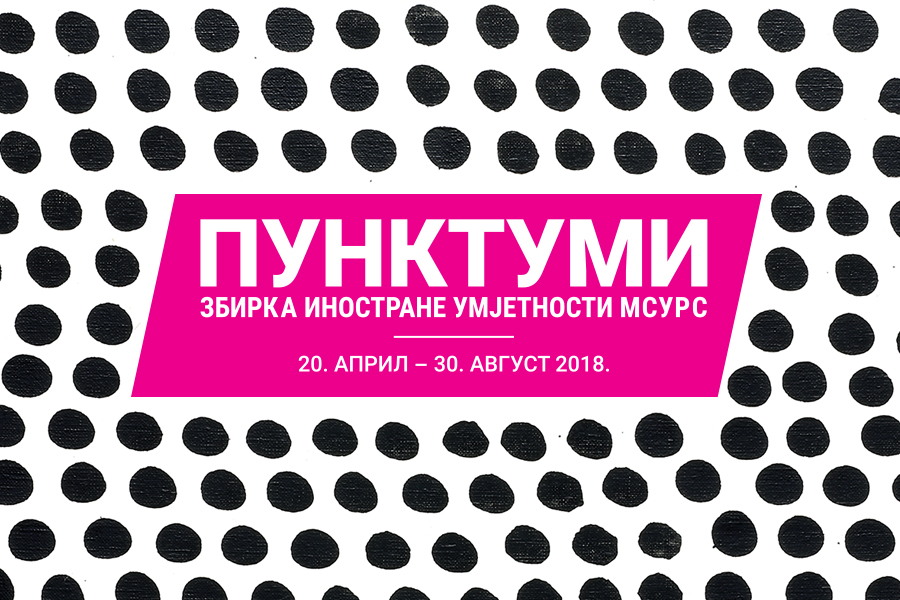The exhibition “Highlights: The Collection of Foreign Art of the Museum of Contemporary Art of the Republic of Srpska” is being staged to mark 2018, declared the European Year of Cultural Heritage by the European Commission, under the slogan “Our heritage: where the past meets the future” and in celebration of Europe’s rich and diverse cultural heritage.
The MSURS collection holds more than 360 artworks, of which 100 works by 80 artists from 17 European countries were selected for the exhibition (Austria, Belgium, Bulgaria, Great Britain, Georgia, Italy, Ireland, Hungary, Norway, Germany, Poland, Russia, Turkey, France, the Czech Republic, Switzerland, and Spain). To underscore the richness of Europe’s heritage, as well as the measure to which the legacy kept by the MSURS will act as a powerful incentive for its future work, let me mention the names of some of the artists being exhibited: Otto Piene, Günther Uecker, and Heinz Mack from the ZERO Group; Friedensreich Hundertwasser; Hans Hartung; Pierre Alechinsky; Stanley William Hayter; Jean Messagier; Zao Wou-Ki; Shōichi Hasegawa; Yasse Tabuchi; and Antonino Virduzzo.
It is the European Year of Cultural Heritage, so what better opportunity could there be for the Museum of Contemporary Art of the Republic of Srpska (MSURS) to “unearth” its hidden treasure – its remarkable collection of foreign art – for its audiences and the world to see? The exhibition of the MSURS collection of foreign art takes place at an opportune moment for remembering the Solidarity Campaign, an event that mobilised an army of artists from across Europe and the world to bestow their works on Banja Luka, in hope of the city’s speedy recovery after the massive 1969 earthquake. During the Solidarity Campaign, which lasted between 1969 and 1975, more than 750 artworks arrived in Banja Luka from around the former Yugoslavia, Europe, and the world, providing a solid basis for building the Museum and its core holdings. Apart from the Solidarity Campaign, with which the collection began, what helped it grow over this initial period was the works donated after the 7th Autumn Salon. A major biennial art show launched in 1962, that year it was also an international event, called the 1st International Autumn Salon. Held in 1975, the exhibition brought together a great number of foreign painters, printmakers, and sculptors, primarily those whose work was significantly related to Paris, thus connecting artists from China, Japan, and other parts of the world with Europe’s cultural heritage. It is thanks to these presents by the international artists who took part in the Salon and so joined the Solidarity Campaign that the MSURS safeguards a great many works by distinguished artists in its foreign collection, diverse to the extent it poses a real challenge even for experienced researchers and scientists.
This outstanding collection has never before been presented in the way it deserves, remaining practically unknown to the general public. For that reason, the MSURS launched this special project to direct public attention to the collection, and by doing so to promote the European cultural heritage it safeguards. This is a welcome opportunity for these valuable works of art to be re-evaluated by experts and adequately restored and conserved. At the same time, the works are being shown in keeping with the latest standards of museological presentation of cultural heritage, in a way meant to establish a different kind of communication with the MSURS audiences, encouraging citizens to investigate Europe’s rich and diverse cultural heritage.
Organising this exhibition was a feat that will keep us profoundly indebted to Professor Lidija Merenik from the Chair of Modern Art of the Faculty of Philosophy in Belgrade. Professor Merenik’s support was not only professional, but also a sign of true amicability, as she assisted with organising the show, selecting the exhibits, and carrying out a detailed analysis that resulted in new information being gained and presented in her text featured in this publication. We are also genuinely grateful to Professor Zvonko Maković and Tijana Palkovljević Bugarski, Ph.D., who reviewed this publication, as well as to the Museum of the Republic of Srpska, for its cooperation and support, and for the help we received from their conservation-restoration team, Dijana Pešikan Egić, senior conservator, and Đurđica Bjelošević, painter-restorer.
Among those who devoted a great deal of effort to prepare the exhibition, study, describe and document the collection, photograph the exhibits, and get it all ready for publication are Žana Vukičević, senior curator and collection curator at the MSURS, Nemanja Mićević, MSURS photogrpaher and graphic designer, and Mladen Šukalo and Nenad Markić, MSURS technicians.
What places special importance on this project is the financial support of the Office of the Head of the Delegation of the European Union to Bosnia and Herzegovina and European Union Special Representative in Bosnia and Herzegovina, His Excellency Lars-Gunnar Wigemark; the UNESCO Regional Bureau for Science and Culture in Europe, Antenna in Sarajevo and Mr Siniša Šešum; the Embassy of Italy in Sarajevo and His Excellency Nicola Minasi; the Ministry of Education and Culture of the Republic of Srpska; the Ministry of Civil Affairs of Bosnia and Herzegovina; and the City of Banja Luka; the results of this tremendous achievement would not be nearly as visible without their great support. We are sincerely grateful to all those who selflessly devoted their energy and time to make it possible for the Museum of Contemporary Art of the Republic of Srpska to duly present a project that will easily bear comparison with any of those found in the portfolio of projects carried out to mark the European Year of Cultural Heritage.

